The weather in Spain is changeable now. It is still beautiful and warm in the sun, but if you happen to be in the shade or out after 4 pm, it is cold. What better way to heat up than to enjoy some of Spain’s traditional winter comfort foods? Most bars will feature some or all these stews, roasts, and soups on their menu del dia.
The last two on the list are extras and are eaten at different times of the day. Churros are for breakfast. And roast chestnuts can be bought from street corners throughout Spain at this time of year. Please note, most traditional dishes on this list are not suitable for vegetarians…
Caldo Gallego
Caldo Gallego is a Galician soup popular in northern Spain. It is a hearty soup and is so good, you will want to eat it the minute it hits your table. It consists of white beans, Galician potatoes, pork, Galician chorizo, cabbage, and other greens. Perfect after walking the Camino de Santiago.
Cocido Madrileño

Cocido Madrileño
My neighbours are from Madrid, and I am lucky enough to share this lunch with them often. However, it is not just lunch – it is more of an event that comes in two or three parts. It is definitely something to relax and take your time enjoying with a nice glass or two of wine.
First to arrive is a large bowl of broth from the stew. This will also have fine noodles in it (fideos). Next comes the potatoes, carrots, cabbage, and chickpeas (garbanzos). Last come the meats. Although sometimes, parts two and three are served at the same time. There is always a selection of meats, such as chorizo, beef shank, chicken, serrano ham, black pudding (morcilla), pork fat, and pork belly.
This is one of the most perfect winter foods in my opinion.
Arroz con Bogavante
A dish typical to many Spanish coastal towns, rice with lobster, and tomatoes are amazing. Fresh lobster is available in Spain from October through to the end of the year. The dish is served as an extravagant broth soup.
Fabada Asturiana
Indulge in a bowl of fabada Asturiana. Another amazing, hearty stew made with white beans, morcilla(black pudding), pancetta, chorizo, and shoulder of pork. Traditionally in this part of northern Spain, a glass of cold cider would accompany the Fabada. Did you know around 80% of cider produced in Spain is consumed in Asturias?
Sopa de Pescado
One of my favourites to make as it is always received well, and everyone always wants at least two bowls. Eaten piping hot with fresh bread, it is very special. I put almost everything in it, mixed seafood, langoustines, mussels, and usually one or two different types of fish. I also add vegetables (just whatever I have to hand) plus tomatoes, tomato frito, and some broth/caldo (any flavour).
Sopa de Lentejas (lentil soup)
Another one of my favourite winter dishes in Spain. Rich in flavours of chorizo, and substantial enough to be a meal on its own. Filled with lentils, carrots, potatoes, onions, chorizo. This is definitely a winter warmer. Even more so, if you add some pickled peppers on top or a splash of sherry vinegar.
Traditional Rabo de Toro (Bull Tail Stew)

Rabo de Toro
Bull meat is popular in Spain and has a distinctively rich flavour. The tail of the bull is cooked slowly over low heat with red wine, garlic, tomato and bay leaves. Due to the length of time it is cooked, it just melts in your mouth. This is a typical dish in Andalucia. Served in its own juice with potatoes and veg.
Huevos Rotos (Egg and chips)
This doesn´t sound particularly Spanish, but trust me, it is! It is a very popular dish. A plate of roast potatoes or chips with two perfectly fried eggs on top. Also usually served with a fried green pepper and some serrano ham. The “roto” part, is traditionally when the waiter serves the dish, he breaks the egg yolk allowing you to dive in and enjoy!
Carrillada or Carrillera (Cheek)
Beef cheek (or pork) covered with wine and broth/caldo and some herbs and cooked until tender. As with the bull tail, serve with veg and potatoes. Mash potatoes are perfect with this.
Sopa de Ajo (Garlic soup)
Sopa de Ajo might sound a bit of a strange main ingredient for a soup. I put garlic in every soup I make, but always as a side ingredient. However, it can be surprisingly subtle and scrumptious! It is a simple recipe with few ingredients. A ham bone is used to create the broth. You can then add chunks of cooked ham with plenty of garlic and some paprika to add a little kick. As you serve it add a poached egg to the top. This is also perfect for using up “day old” bread.
Also read: Top 20 Spanish ‘horror’ dishes
Bacalao con Coliflor (Cod with cauliflower)
Another dish from the north is bacalao con coliflor. It literally is what it says. Salted cod with cauliflower. You can of course add potatoes and veg and perhaps a little cheese sauce.

Callos a la Madrileña
Callos a la Madrileña (Tripe stew)
This is a classic tripe and tomato-based stew from Madrid. It is cooked slowly in broth over low heat. The tripe used is traditionally pig or cow but can also be lamb. Chorizo, black pudding, and spices can also be added.
Atascaburras
I will let you translate this one for yourself, but it is a very easy dish to make (similar to the Portuguese Bacalhau à Brás in my opinion). It is made on the stovetop with salted cod. Steeped in water and rinsed many times – overnight at least. Broken up and mixed with boiled potatoes, olive oil, and garlic (I like to add grated onion too). Just mix all together, cook, and serve. The Portuguese version also adds a raw egg to the mix.
Cordero Asado (Roast leg of lamb)
A slight change from the Sunday roast as we know it. Popular winter foods in Spain are roast leg of lamb or goat served with veg and a choice of potatoes. Or why not include a couple of different types from chips, roast, patatas a lo pobre, or mash.
Basque chicken
Tender chicken, chorizo, and red peppers, in a rich sauce, this is an incredibly simple but tasty dish from the Basque Country.
All of these dishes can be found throughout Spain. But they are also very filling and inexpensive to make. The most important factor with many of these is the cooking time. If you have a slow cooker, then you have no excuse to try and make some yourself.
Churros
A mug of thick hot chocolate with freshly fried churros just read to dip in and enjoy.

Roast Chestnuts
Chestnuts
You can buy these in the markets and supermarkets to make at home. However, a wander through the villages throughout Spain in winter is not complete without stopping off and ordering some roast chestnuts. There is nothing like it.
Related post: The Spanish culinary autumn


